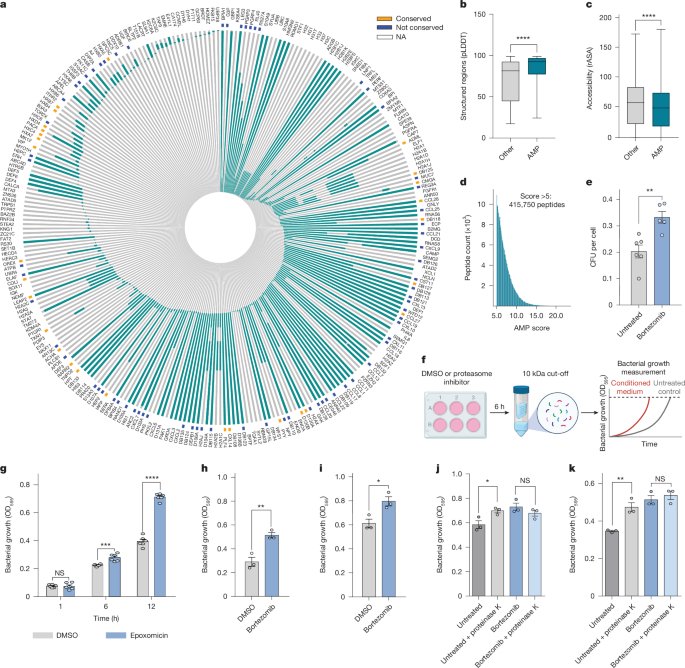Cell-autonomous innate immunity by proteasome-derived defence peptides
IF 50.5
1区 综合性期刊
Q1 MULTIDISCIPLINARY SCIENCES
引用次数: 0
Abstract
For decades, antigen presentation on major histocompatibility complex class I for T cell-mediated immunity has been considered the primary function of proteasome-derived peptides1,2. However, whether the products of proteasomal degradation play additional parts in mounting immune responses remains unknown. Antimicrobial peptides serve as a first line of defence against invading pathogens before the adaptive immune system responds. Although the protective function of antimicrobial peptides across numerous tissues is well established, the cellular mechanisms underlying their generation are not fully understood. Here we uncover a role for proteasomes in the constitutive and bacterial-induced generation of defence peptides that impede bacterial growth both in vitro and in vivo by disrupting bacterial membranes. In silico prediction of proteome-wide proteasomal cleavage identified hundreds of thousands of potential proteasome-derived defence peptides with cationic properties that may be generated en route to degradation to act as a first line of defence. Furthermore, bacterial infection induces changes in proteasome composition and function, including PSME3 recruitment and increased tryptic-like cleavage, enhancing antimicrobial activity. Beyond providing mechanistic insights into the role of proteasomes in cell-autonomous innate immunity, our study suggests that proteasome-cleaved peptides may have previously overlooked functions downstream of degradation. From a translational standpoint, identifying proteasome-derived defence peptides could provide an untapped source of natural antibiotics for biotechnological applications and therapeutic interventions in infectious diseases and immunocompromised conditions. Proteasomal degradation of cellular proteins generate defence peptides constitutively and in response to bacterial infection. Such peptides might provide a source of natural antibiotics that could lead to biotechnology applications and therapeutic interventions.


求助全文
约1分钟内获得全文
求助全文
来源期刊

Nature
综合性期刊-综合性期刊
CiteScore
90.00
自引率
1.20%
发文量
3652
审稿时长
3 months
期刊介绍:
Nature is a prestigious international journal that publishes peer-reviewed research in various scientific and technological fields. The selection of articles is based on criteria such as originality, importance, interdisciplinary relevance, timeliness, accessibility, elegance, and surprising conclusions. In addition to showcasing significant scientific advances, Nature delivers rapid, authoritative, insightful news, and interpretation of current and upcoming trends impacting science, scientists, and the broader public. The journal serves a dual purpose: firstly, to promptly share noteworthy scientific advances and foster discussions among scientists, and secondly, to ensure the swift dissemination of scientific results globally, emphasizing their significance for knowledge, culture, and daily life.
 求助内容:
求助内容: 应助结果提醒方式:
应助结果提醒方式:


